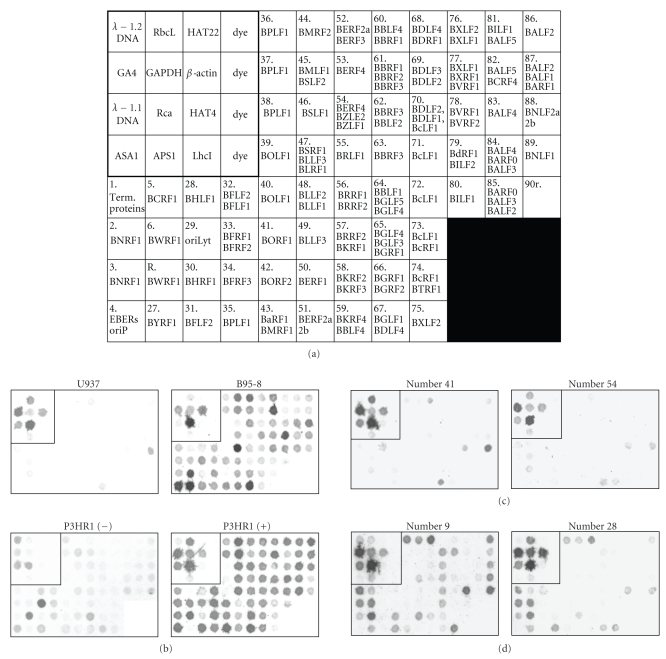Figure 1.
Production of EBV-chip for hybridizing with cDNA samples derived from OSCC biopsies. (a) 16 control and 71 EBV DNA fragments were organized into an 8-row by 12-column format with the size of 4.2 × 2.4 mm, as specified in the previous report [29]. The controls are located at the upper left corner included in the square box, where it contains 12 DNA fragments for 1.2 and 1.1 kbp Pst I-digested-lambda bacteriophage DNA, plant APS1, ASA1, GA4, HAT4, HAT22, LhcI, RbcL, and Rca genes, and human GAPDH and β-actin genes. In addition, there were four dye spots that served as the negative controls. Outside the control region, 71 EBV DNA spots, with the gene names, covering the entire EBV genome were arranged in a sequential order on EBV-chip, except that spot R was interrupted between Spots 6 and 27. Spots R and 90r contained EBV W- (internal) and terminal-repeated, respectively, sequences. The arrangement of viral DNA on EBV-chip could facilitate identification of expressed genes shown in hybridization images. (b) Total RNA samples were isolated from U937 cell line, EBV-producing B95-8 cell line, and P3HR1 cell line treated without (−) or with TPA and SB to induce the EBV lytic cycle (+), followed by EBV-chip hybridizations. One of each of the representative reproducible images of these hybridization experiments is shown in here, with the control regions boxed. Since U937 cells were EBV-free, no specific signal on EBV-chip spot was detected (the light color in 90r was the nonspecific hybridization signal, as discussed in the Results section). The RNA samples derived from B95-8 and P3HR1 (+) cells contained EBV transcripts, and therefore lots of, if not all, spots showed dark color, whereas a limited number of spots yielded signals when using EBV-latent P3HR1 (−) cDNA in hybridizations. (c) Cases numbers 41 and 54 were among those 10 EBV-negative OSCC tissues, and basically EBV-chip hybridizations of their cDNA samples revealed no expression signal. (d) Two EBV-positive tissues, numbers 9 and 28, contained substantial numbers of EBV transcripts that resulted in many dark spots in EBV-chips. The intensities of the spots were subsequently quantified and subjected to comparative analysis, as shown in Figure 2.

